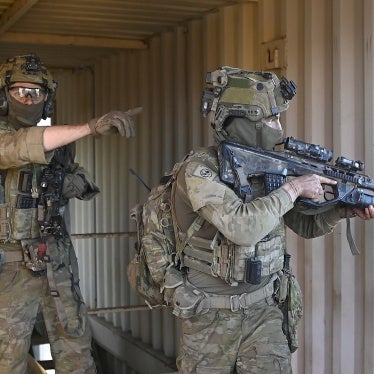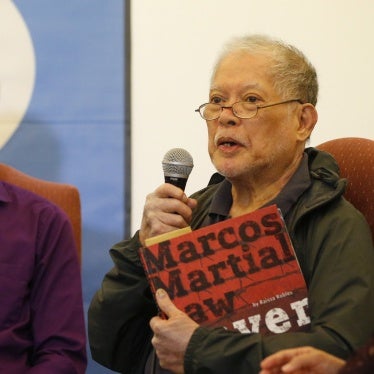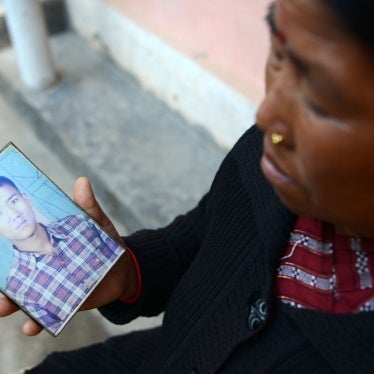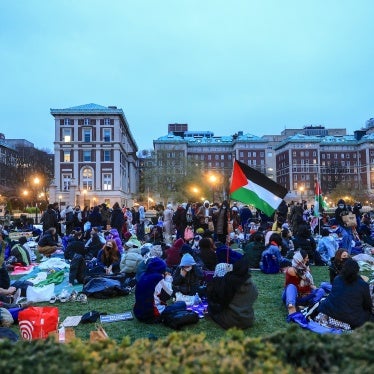RANGOON, Burma — Here in Rangoon, the never-ending visits of trade delegations, a flurry of bilateral meetings, and a rampant real estate boom still buoy Western optimism about the reforms undertaken by the Burmese government. Out in the countryside, though, the sense of feverish optimism has been dampened by the recent sectarian violence between Burmese Buddhists and Muslims. Elsewhere there's the simmering conflict in Kachin State, which has become a cause célèbre for the country's assertive civil society, a source of embarrassment for the reformist government, and a major question mark over the future role of Burma's powerful armed forces.
The military's commander-in-chief, General Min Aung Hlaing, addressed the country at the Armed Forces Day parade in March, attended for the first time by opposition leader Aung San Suu Kyi, and declared that "the military adheres not only [to] civil and to martial laws and regulations, but also to the Geneva Convention." The problem is that the general's claim ignores the provisions of Burma's 2008 Constitution, which stipulates a leading political role for the armed forces -- not to mention decades of well-documented breaches of international humanitarian law and domestic military law committed by the Burmese military.
Fighting between the Burmese army and ethnic Kachin insurgents has raged in the north of the country since mid-2011, displacing over 100,000 civilians and reportedly generating high government and rebel casualties. Fighting intensified in December, with a rare use of air power by government forces that brought them closer to the rebel stronghold of Laiza astride the Chinese border. In recent weeks, a tenuous ceasefire was agreed though sporadic fighting continues, and there are indications that the Burmese army is using the lull to reinforce and resupply troops in the area under the cover of aid convoys.
Some Western policy analysts and several diplomats in Rangoon suggested that the central orders for the offensive did not come from the president's office, and some Western observers have told me in private conversations that a "rogue commander" was at work, out of the control of the president and commander-in-chief. Continued army operations were cast as "defensive actions," interpreted liberally from the president's orders by troops on the ground, even as the speaker of the lower house of the national parliament and former general Thura Shwe Mann and members of the Burmese parliament were calling for the fighting to be stopped. The confusion begs the question: If the president's frequent calls for a ceasefire haven't been heeded, then who really controls Burma's military?
A close reading of the 2008 constitution makes clear that the president and the parliament have only tenuous control over the military; they have, indeed, no real control at all. Claims that Thein Sein is trying to "rein in" the army or bring them under "civilian control" are disingenuous: He cannot constitutionally rein in an institution over which he has no authority. Chapter Five of the constitution vests most of the power to make national security decisions, or "appropriate military action," in the National Defense and Security Council. Little is known about the internal operations of this 11-member council. Six members are serving military officers: the commander-in-chief of the defense services General Min Aung Hlaing and his deputy, the minister of defense, the military-appointed vice-president (Burma has two vice-presidents), and ministers of border affairs and home affairs. Among the five ostensibly civilian members, there are four who are former military officers, including the president, the minister for foreign affairs, the civilian appointed vice-president, and the speakers of the upper and lower houses of parliament, including Thura Shwe Mann, himself a prominent commander from offensives against Karen insurgents in the 1990s.
The Burmese military has further powers. The constitution gives it control over its budget, recently estimated at one-fifth of government expenditure (far more than health and education combined). It maintains immunity from the civilian justice system. And it is empowered by the vaguely worded directive that the "Defense Services shall take the lead in safeguarding the Union against all internal and external threats." The president appoints the commander-in-chief of the military, but only following the "proposal and approval" of the National Defense and Security Council.
These are extraordinary powers for any military, but hardly surprising given that the current generation of Burmese civilian leaders was instrumental in drafting the constitution precisely to preserve the influence and immunity of the Burmese military. So there is no constitutional basis for assuming that the president has any serious power to control the everyday operations of the army. Even Aung San Suu Kyi, who has received mounting criticism for her failure to speak out on abuses in the Kachin conflict, noted in January that "if the commander-in-chief did this [military offensive] on his own judgment, I must say that according to our current constitution he is entitled to do so."
Burma's parliament recently announced the formation of a constitutional review mechanism, passed unanimously by the bicameral national assembly. The increasingly influential speaker of the lower house, Thura Shwe Mann, stated, "[i]t is natural that any law, however perfect it may be, will need to be adjusted, according to changes over time, when it is found to be inappropriate for internal and international political, social and economic conditions," a decidedly brazen statement from a leading figure of the military who drafted the constitution. The issues tackled by this new review board will likely look at ethnic issues arising from the nascent ceasefire process as ethnic leaders voice objections to provisions in the charter, and restrictions that preclude Aung San Suu Kyi from running for president. The powers of the military are still largely a taboo subject in Burmese politics, and it is unlikely that parliament, at least ahead of the 2015 elections, will attempt to unravel the authoritarian threads running throughout the constitution and unsettle the military.
There is also little basis to conclude that local commanders, enraged by high casualties to their own forces (possibly in the thousands), somehow acted on their own initiative and undertook a major offensive against the Kachin insurgents -- an argument that seems designed to shield the president from the mounting opprobrium from ongoing hostilities and abuses. The use of airstrikes, including by Russian manufactured Mi-24 attack helicopters and Chinese-supplied light aircraft, has been rare in Burma's civil wars. And the last offensive deployment of forces this size -- an estimated 1,500 heavy mortar rounds were fired one day in January -- took place during the battle for Sleeping Dog Mountain in Karen State in 1992. Sustained use of air power, based in central Burma, and the rotation of division-size infantry units from throughout the country, simply cannot be ordered by a local commander. The escalation of fighting over the past three months could only have occurred with the approval, if not on the orders, of the central War Office in Naypyidaw, the capital.
By claiming that the Burmese leadership is not responsible for the major military operations in Kachin State, some military analysts and academics have sought to deflect blame from senior commanders for ongoing laws-of-war violations. But abusive behavior by the Burmese military in counter-insurgency operations -- characterized by attacks on civilians, murder, torture, forced labor, use of child soldiers, and destruction of civilian property -- has been well-documentedfor decades. International law holds commanders responsible for the actions of their troops when they knew or should have known of war crimes and take no action to prevent or punish those committing them.
Constitutional issues aside, no one should be surprised that the government's recent reform efforts have barely touched the army. It will probably be very hard to find former senior military officers in the government with clean hands after decades of dirty civil wars and the repression of popular uprisings. President Thein Sein was himself a regional commander in northeastern Burma from 1999 to 2002, where he commanded large-scale operations against ethnic Shan rebels. They are the product of a system that has changed little in an era of reform.
There are growing calls for engagement with Burma's military, particularly by Australia, which recently announced a resumption of limited military engagement, and increasingly the United States. Such contacts are likely, however, to be confined to discussions on rules of engagement, compliance with international humanitarian law, and basic logistics to reduce the military's reliance on forced labor. The International Labor Organization (ILO) reached an important joint strategy plan with the Burmese army in July 2012, in which it promised to eradicate forced labor and associated abuses, such as use of child soldiers and the widespread practice of "self-sufficiency" -- essentially a license to plunder, tax, appropriate land and livestock and use civilians as a financial resource. Any engagement with the army could well use the ILO's efforts as a starting point for principled and productive engagement.
But the central challenge to Burma's reform is to bring the country's military under genuine central government control. Amending the constitution so that the army is obligated to do what the government tells it to do is a crucial step. Only then will there be hope that future elected leaders will have the authority and power to ensure civilian control over national defense -- and ultimately democracy in Burma.






